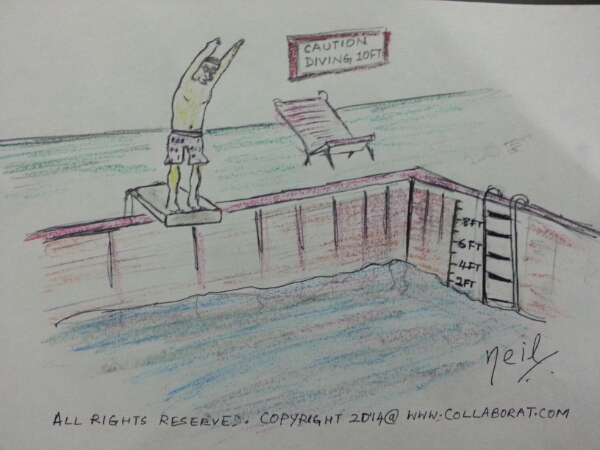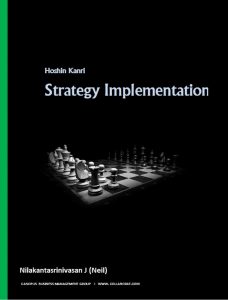Hoshin Kanri (Policy Deployment) is a Japanese method for strategy formulation, cascading and implementation. Many organizations practice Hoshin Kanri (Policy Deployment) including HP, Bridgestone, M&M, Suzuki, Toyota, Honda, Ford, TVS, Bajaj, etc., Many Indian companies across sectors, including Manufacturing and BFSI. Its roots are from Total Quality Management (TQM).
In India, most conglomerates use Policy deployment for Long Range Planning.Why is Hoshin Kanri (Policy Deployment) unique?
- Acute focus on Implementation or execution orientation
- Drive Individual Ownership and Joint Accountability of different functions
- Interactive Top-down deployment methods to create buy-in between senior & mid management
- Involve all levels of employees in strategy implementation
- Prioritize efforts on most important strategic initiatives
Our proven expertise in Hoshin Kanri (Policy Deployment) include :
- Led Hoshin Kanri (Policy Deployment) implementation across complex environments and multiple geographies over multiple business cycles
- Exposure to Hoshin Kanri (Policy Deployment) implementation in Manufacturing and Services
- Adaptation of Hoshin Kanri (Policy Deployment) approach to suit company culture
- Integrated financial planning, employee performance planning and strategic planning
- Facilitated multiple strategic planning workshops
- Led and mentor several strategic initiatives (projects)
- Conducted Hoshin Kanri (Policy Deployment) master class to business leaders
I asked one question to a handful of employees across various levels and functions in an organization, starting from the CEO – ‘What is your company’s strategy?’ I was startled to learn that nearly every one had their own version of the company’s strategy. Some were close and others way apart from the originally conceived strategy. This might sound like an aberration and communication issue to you. I beg to present that this is merely a symptom of an underlying problem in the organization. When different functions and roles in the organization perceive strategy differently, that in itself is the starting point for an implementation failure.
While strategy formulation is traditionally driven by well devised and tested methods, it is widely accepted that there is lack of definitive method for strategy implementation.
I have put together an e-book titled “Hoshin Kanri: Strategy Implementation”. The purpose of this book is to provide necessary knowledge and insights for a leader who has to steward strategy implementation in his/her organization. I can assure you that it will be a good starting point. From my experience, I can observe that Hoshin Kanri fills that gap in strategy implementation by providing an robust method to deal with complex scenarios.
Further Assistance
- I would be happy to talk to you regarding:
- Evaluating existing strategy implementation practices in your organization
- Guiding in annual strategy offsite
- Facilitating Goals & Strategies cascade vertically & horizontally
- Build cross functional ownership and accountability
- Hoshin Kanri Deployment
- Coaching on Execution Excellence to build strong second level teams for execution

Consider the following facts about Business Strategy:
- While 80% of organizations have 3 year ‘Goals’ they hardly have any defined strategy!
- 80% of all organizations that have well-defined strategies fail to execute them well.
- Less than 5% of employees understand an organization’s business strategy.
- 60% of organizations don’t link strategy and budgeting.
- Large enterprises are no way better than the smaller ones. In fact, most large enterprises have a well-crafted business strategy, but they fail in Execution!
Source: Large Research Organizations & Consulting firms such as Wharton, Renaissance Consulting, etc
No matter how great your Strategy is, it wouldn’t make any difference, as long as it is not implemented well.
Remember, unless your strategy isn’t grossly wrong, mostly strategies would yield equally good results as long as implementation is seamless.
Rolls-Royce and Ford have completely different strategies and both of them are successful. Think about it.
One real reason for your organization to fail is not wrong Strategy, but its poor execution. To ensure that does not happen, there are certain skills and experience that are critical :
- Bulky strategy dossiers don’t matter when it comes to implementation. People who submit such dossiers and leave implementation to you are not the right people to implement strategy. Instead, you will need change agents wo are going to work side-by-side to implement your strategy.
- When it comes to strategy implementation, industry or sector expertise doesn’t matter. Remember that only to advise you on the next strategic move, sector experience is critical. Instead look for down-to-earth professionals with functional expertise in organizational change, metrics deployment, goal setting, etc.
- Professionals with proven functional expertise in areas such as Business Transformation, Change Management, Finance, Risk, Technology & Leadership Development would really matter.
- Most leaders approve the show of aggression as good execution-ability. But execution is a skill that requires good precision, patience, judgment, clarity and persistence. Strategy Implementation is both an art and science of execution.
In a nutshell, the right strategy implementation professionals will stitch together your organization to fulfil your strategy.
There are the top 10 challenges in strategy implementation in the order of significance. Does your organization face these challenges? And what are you doing about it?
- Lack of ‘Individual Ownership & Joint Accountability’ for organization goals
- Non-synchronized effort between leaders/functions in applying a strategy
- Budgetary Planning, Strategic Planning & Performance Planning non-synchronized
- Leaders give great talks on prioritization, but they don’t prioritize strategic initiatives
- Strategic Initiatives aren’t scoped well – punctuated with long duration & unrealistic goals
- Too many strategic initiatives run concurrently leading to strategic fatigue
- Most strategic initiatives bet on the same best guys around leading naturally to under performance
- Strategic Initiatives evolve from a wish list rather than from environment scanning
- No QUANTITATIVE measures of success for strategic initiatives
- No systematic mechanism to adapt strategy to changes in external & internal environments
Interview: Organizational Strategy Challenges & Solutions
Extract of an interview of Neil published in Consultants Review Magazine about Organizational Strategy Challenges and Solutions
The economy stands at a crucial juncture now and constant endeavour for excellence and accuracy has come to be more pivotal than ever before.
The goal now is to focus on industry needs with a futuristic perspective, in order to foresee the norms of tomorrow. Canopus Business Management Group (CBMG) is a business services firm that focuses on strategy implementation & business transformation to make them future fit, and it is this approach that has brought them a fair amount of success already. Incepted in 2009, by the MIT educated Nilakantasrinivasan Janakiraman(Neil), CBMG started operations in Chennai, with the vision of bringing something fresh to the consulting space. Read More
We are delighted and honored to share that Consultants Review Magazine has selected Canopus Business Management Group among 25 Most Promising Management & Strategy Consultants in India.
An extract from May 2015 Issue:
“Over the past decade the corporate world has witnessed dramatic shifts in its form, fi nance, marketing,HR,and outsourcing have all faced the change that is slowly gripping the entire sector. Devising business strategies, global marketing,and innovating new products now form the core of developing a business. In this changing arena, defi ning management & strategy consultants only in the role of advisors would be an understatement. Read More.
Most Promising Management & Strategy Consultant
 Prioritization is difficult but we don’t have a choice, be it in Strategy implementation or elsewhere.
Prioritization is difficult but we don’t have a choice, be it in Strategy implementation or elsewhere.

Know the ‘real’ scope of your projects before you jump into them. Most stategic projects never get completed just for this reason.
Indeed they are different; Most widely accepted definition of a consultant is an expert or a professional in a specific field and has a wide knowledge of the subject matter and one who provides advice in that field.
So by definition a consultant has very limited execution responsibility. However commercialization of the ‘Consulting Industry’ and intense competition has led to a situation where firms promise to own or share responsibility of execution. But in reality, they primarily role is to advise so things fall through the cracks as the engagement proceeds.
Due to their envious position as subject matter experts, consultants usually have an upper hand in their relationship with clients. Many times, this biased relationship is not very conducive for building trust and confidence between both the parties.
“The test of a good consultant is not whether he or she has generated a unique insight, but whether the insight can be applied to produce positive results. Consultants can’t just be smart; they have to be capable of delivering a business outcome” – The Economist
That is why consultants are usually criticized for the following:
- Theorizing problems and making them difficult to comprehend
- Heavy usage of Jargon!
- Force problems into a ‘methodology’ they know
- Attempt to make projects bigger or longer than they need to be
- Produce an elaborate dossier called ‘Project Report’ that reiterates the problem
Not all consultants have such deficiencies, but it is very prevalent.
‘Collaboration’ on the other hand is a recursive process where two or more people or organizations work together intersection of common goals – for example, an intellectual endeavor that is creative in nature -by sharing knowledge, learning and building consensus. Collaboration does not require directive leadership and can sometimes bring better results through decentralization and egalitarianism.
Traditionally, collaboration is widely popular among authors, academicians & researchers. These are fields where two or more experts with diverse and varied experience work together to towards a common goal. So ‘execution & result orientation’ is at the heart of collaboration. And unlike consulting, there is no role to just ‘advise’ and not own execution.
Good collaboration has the following elements:
- Tactical – Where one tells other teams members specifically what to do in his/her areas of expertise
- Tacit – Where one trains other members on how to handle issues/situations beyond technical stuff
- Co-delivery – Where one dirties his/her hands and work together with the team
- Partnership – Where one recognizes that they are not experts in all disciplines. Hence he/she partners with other experts in the team
There is no need to emphasis which one is better when it comes to ‘change management’. Collaborative style of change management is several notches above consultative style.
Known in short as Neil, Nilakantasrinivasan helps individuals and organizations to improve their performance, profitability and processes.
He is an expert in Operations Management, Customer Experience & Project Management.
Neil’s approach is not to prescribe any ‘methodology’. Instead he uses his experience with Hoshin Kanri, Balance Scorecard, LEAN, TQM, Six Sigma, Triz, Theory of Constraints, Knowledge Management, industrial engineering methods, ISO, PCMM, etc to deliver a composite solution that will resolve the pain points and improve profitability, productivity & process.
Targets Series#2 : Matsushita example of Top-down approach to deploy targets
Here’s a live case that I read from The TQM Magazine, Volume10, Number 6, 1998 by Yoshio Kondo. I liked it and thought it is very apt and also interesting to read.
“Matsushita Electric Industries’ Car Radio Division received a demand from one of its customers for a 10 percent price reduction. The leadership team put their heads together to try to meet this request but, after much discussion, reached the conclusion that they would be unable to achieve such a large price cut even by implementing all the cost reductions they could think of. They therefore decided to convey this to the customer. When this information reached the company’s chairman, Konosuke Matsushita’s ears, he said, “Whenever we receive a demand for a price reduction from our customers, it is our practice at Matsushita to work out how we can achieve an even greater cost reduction – in this case 15 percent. Please think about this again”. After receiving this instruction from their company’s founder, everyone involved started investigating the possibility of reducing costs even more thoroughly and eventually succeeded in cutting them by 13 percent. When this success was announced to him, Matsushita reportedly made a personal visit to the automobile company that had requested the price reduction and said, “Thanks to your request for a 10 percent price reduction, my company has succeeded in reducing its costs by 13 percent. We are extremely grateful to you”.
It is an example of successful top-down deployment. What made it work?
- Demand came from customer directly
- Matsushita’s stature & position – People had immense respect for him, but he was also the Chairman & Founder
- This was in Japan and happened in the middle of last century
You and I know that it’s not possible for Managers to demonstrate such authority in today’s matrix culture. All the fat has already been sucked off and there’s nothing much to squeeze further in the system.
In spite of these deficiencies, it’s easy for a manager to give a one-way message and walk-off. So top-down is still very popular.
There’s a great opportunity to adapt ‘catch-ball’ technique which overcomes most deficiencies of top-down approach.
Sign-up for collaborat newsletter

